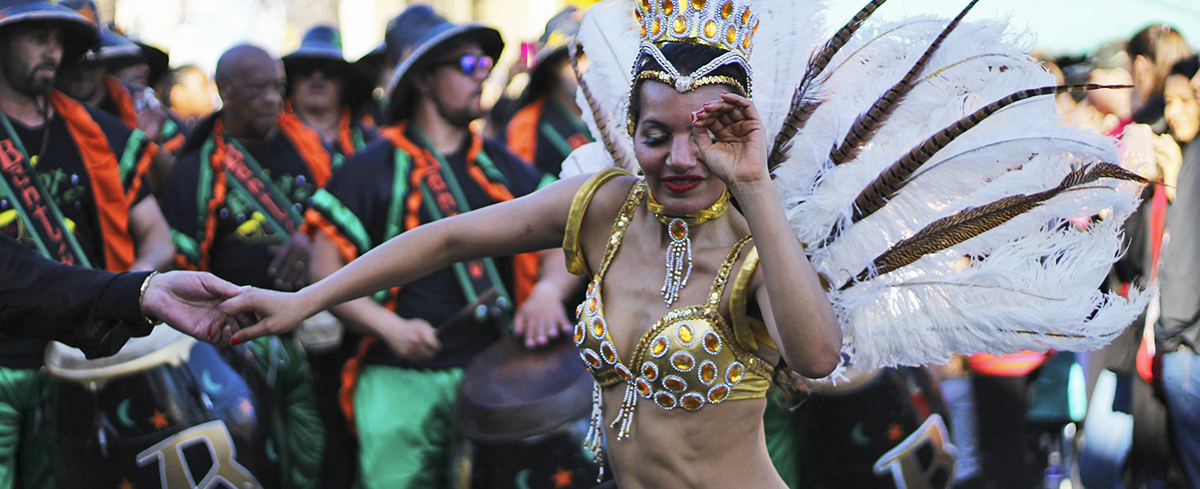“Candombe, candombe negro; nostalgia de Buenos Aires . . .”
The lyrics of old tangos and milongas speak with nostalgia of Buenos Aires’ African legacy, yet the spirit of candombe has not been lost in the past. If you know where to look, you can still find drummers and dancers winding their way down colonial cobbled streets, the rhythms ricocheting off the facades of old tenements and reverberating through packed crowds.
A bit of history

The word candombe was first written down in the 18th century to describe the mix of music, dance and a fusion of Bantu and Catholic religion developed by Angolan and Congolese slaves in Spain’s Río de la Plata territories - now Argentina and Uruguay. After an independent Argentina abolished slavery in 1853, African communities gathered in nations in the neighbourhoods of Monserrat and San Telmo, where they continued to practice a tradition that became a pivotal influence on the development of the city’s native tango. Candombe and Afro-Argentine traditions in general fell in and out of favour during different political regimes, but the legacy lives on.
The call

It’s 5pm on a warm spring evening in La Boca and the streets echo with a cacophony of drums. In front of a row of old immigrant tenements made of wood and sheet metal, more drums - those of the next comparsa - lay around a fire. The skins are being warmed in preparation for the spring “llamada” or calling, an annual meeting of candombe troops - comparsas - from all over the city. It’s called a llamada because drummers play to “call” their brothers, who in turn respond with their own rhythms. Today thirty comparsas, some with dozens of drummers and dancers, will take their turn to march along the street.
The rhythm

A member of the next comparsa checks the drums are ready, then there’s a group hug and the group sets off. The drummers belting out an incessant rhythm, the dancers moving freely, carried by the beat. To play candombe, you need a minimum of three people because there are three types of drums - the piano, chico and repique, which together form a cuerda. The sound is heavier, deeper than samba from Brazil because the drum heads are all made from animal hide. Each comparsa has its own personal toque, or rhythm that may fall into two styles: Cuareim and Alsina, both named after streets in Montevideo, Uruguay. The former is slower, more melodic and the latter more aggressive, with a rapid-fire dialogue between the different drums.
The cast

As well as the drummers and dancers, the comparsa features several colourful characters. There’s the star dancer, the vedette; there’s the Gramillero, a dapper witchdoctor with a grey beard, a walking stick and a briefcase full of herbs, who shakes as he dances and represents the old healers of the African nations; Mama Vieja representing the dignity, wisdom and kindness of the African mothers as she dances with her head held high in her white headscarf and her wide 1800s-style skirt, and the Escobero, who performs tricks with his broom.
The contagion
The comparsas who play the tightest and most infectious rhythms soon pick up a snowballing crowd of followers who are not part of the comparsa but follow their progress down the street dancing along with them, while kids run dodging in and out of the crowd. Many people seem to know each other, creating a community family atmosphere. “The rhythm feels raw and savage,” says Luciana Santander, a lawyer and candombe dancer who discovered when she moved to the neighbourhood of San Telmo in the late 90s. “It’s one of the most rustic, savage rhythms that exists because it’s just wood, leather and hand. It’s uplifting and you feel it and share it naturally, creating a communication with both the musicians and the other dancers. It’s contagious; it’s a communal feeling.”
Where to see Candombe today

Several neighbourhoods have their own comparsas who meet regularly to practice. The Kimba comparsa practices most Sunday evenings in Parque Centenario in the Caballito neighbourhood, and several groups practice in the streets of San Telmo on Saturday and Sunday afternoons. The larger llamadas are held on special dates throughout the year including at the start of spring in La Boca, the first weekend of November in Monserrat and the first weekend of December in San Telmo.
Learn more about music in Buenos Aires


